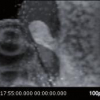Free Online Productivity Tools
i2Speak
i2Symbol
i2OCR
iTex2Img
iWeb2Print
iWeb2Shot
i2Type
iPdf2Split
iPdf2Merge
i2Bopomofo
i2Arabic
i2Style
i2Image
i2PDF
iLatex2Rtf
Sci2ools
ISBI
2008
IEEE
2008
IEEE
Double time-scale image reconstruction of the beating and developing embryonic zebrafish heart
We present a time-lapse collection and reconstruction technique that allows following embryonic heart development at any computationally halted heart contraction state. The central idea is to image at least one full heartbeat at a fast frame rate, resulting in a two-dimensional plus time (2D+T) data set, and repeat this operation every few minutes over several hours for multiple axial positions. The acquired data are five dimensional (X, Y , and Z in space, `fast' and `slow' dimensions in time). The (2D+T) image series are then synchronized to their neighbors in the axial and development time dimensions using a non-rigid registration algorithm (constrained such as to leave all but the fast time dimension unchanged). The algorithm proceeds recursively over the different axial positions and developmental stages. We successfully applied this procedure to image the development of the embryonic zebrafish heart between 32 and 44 hours post fertilization (hpf).
Embryonic Zebrafish Heart | Fast Time Dimension | ISBI 2008 | Medical Imaging | Multiple Axial Positions |
| Added | 20 Nov 2009 |
| Updated | 20 Nov 2009 |
| Type | Conference |
| Year | 2008 |
| Where | ISBI |
| Authors | Michael Liebling, Julien Vermot, Scott E. Fraser |
Comments (0)

